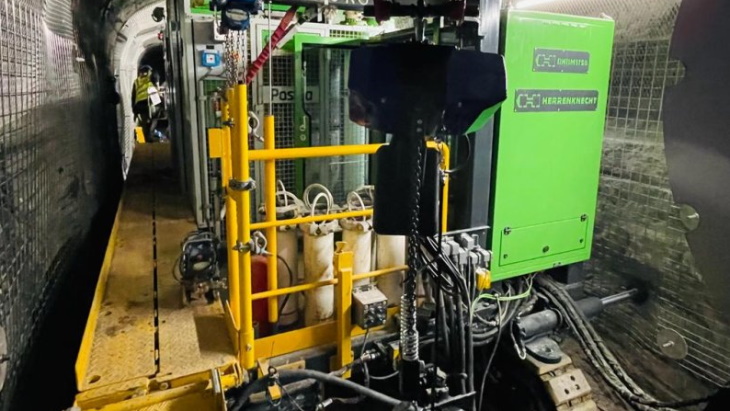Posiva crew gets to grips with drilling machine
Finnish radioactive waste management company Posiva Oy has completed the drilling of the first two deposition holes at the Onkalo underground used nuclear fuel repository near Olkiluoto using a new boring machine which was operated by its own personnel. The holes are located at a depth of 430 metres in the deposition tunnel built for the Joint Functional Test (JFT).

The DHBM drilling rig for drilling disposal holes at Onkalo (Image: Posiva)
The Aava Downhole Boring Machine (DHBM) rig was delivered to the Onkalo site in June 2022 from its German manufacturer, Herrenknecht AG. It is more than 9 metres long, 3 metres wide and almost 4 metres tall, and weighs 78 tonnes. The drilling rig complex also includes a 7-metre and 22-tonne energy unit and a 4.1-metre-high and 18.5-tonne drill processing plant.
The first four holes in the tunnel were drilled in late 2022 as test drilling operations of the boring machine by a crew from Herrenknecht.
Posiva's own crew will drill a total of four holes in the JFT tunnel, bringing the total number of holes in the tunnel to eight. The drilling of the first two of those tunnels has now been completed by Posiva. All four holes are expected to be completed at the beginning of March.
The boring machine was operated by three operators employed by Posiva. Two representatives from Herrenknecht and a crew of two from Germany for the maintenance of the boring machine have remained on site as backup.
"The drilling of the first holes with the DHBM boring machine operated by our own personnel is a significant step forward as Posiva moves towards the start of operation," said Posiva's Programme Manager Kimmo Kemppainen.
He added: "We made several practical observations for production drilling already with these two holes. Some minor teething problems with a new machine. For example, how to support the machine when the tunnel ceiling does not follow the theoretical tunnel profile. The need for sufficient amount of clean flushing water for the boring machine was also established, so as to avoid sedimentation of rock residue from drilling in the flushing system."
At Onkalo, used nuclear fuel will be placed in the bedrock, at a depth of about 450 metres. The disposal system consists of a tightly sealed iron-copper canister, a bentonite buffer enclosing the canister, a tunnel backfilling material made of swellable clay, the seal structures of the tunnels and premises, and the enclosing rock.
In March 2021, Posiva announced that work to excavate an 80-metre-long tunnel had started at Onkalo for the JFT, which involves small-scale final disposal under actual conditions, and is part of commissioning the geological repository. However, the canisters placed in the bedrock during the test will not contain used nuclear fuel, as the intention is to ensure that the methods designed for final disposal operate as planned. The test will be monitored by authorities who will consider the processes of the integrated system test in the context of the operating licence.
Posiva said the JFT is scheduled to start in February 2024.
The site for Posiva's repository at Eurajoki, near the Olkiluoto nuclear power plant, was selected in 2000. The Finnish parliament approved the decision-in-principle on the repository project the following year. Posiva - jointly owned by Finnish nuclear utilities Fortum and Teollisuuden Voima Oyj - submitted its construction licence application to the Ministry of Employment and the Economy in December 2013. Posiva studied the rock at Olkiluoto and prepared its licence application using results from the Onkalo underground laboratory, which would be expanded to form the basis of the repository. The government granted a construction licence for the project in November 2015 and construction work on the repository started a year later.
In July last year, Posiva announced that the excavation of the first five actual disposal tunnels had been completed. The total length of the tunnels, whose excavation began in May 2021, is about 1700 metres.
It is estimated that 100 deposition tunnels will be excavated during the 100-year operational period of the final disposal facility, and will have a total length of about 35 kilometres. The maximum length of each tunnel will be 350 metres. The tunnels will be about 4.5 metres high and about 3.5 metres wide.
The repository - the first in the world for used fuel - is expected to begin operations in the mid-2020s. A similar repository is planned at Forsmark in Sweden.
Researched and written by World Nuclear News
- China Institute of Atomic Energy
- Nuclear Power Institute of China
- Southwestern Institute of Physics
- China Nuclear Power Operation Technology Corporation, Ltd.
- China Nuclear Power Engineering Co., Ltd.
- China Institute for Radiation Protection
- Beijing Research Institute of Uranium Geology (BRIUG)
- China Institute of Nuclear Industry Strategy (CINIS)
- China Nuclear Mining Science and Technology Corporation


